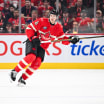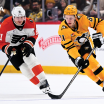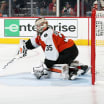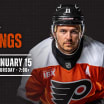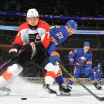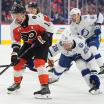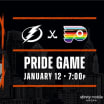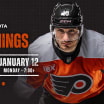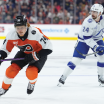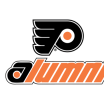- An original member of the Flyers from the time of the inaugural 1967-68 season until he was traded to the Toronto Maple Leafs in a three-team deal with the Boston Bruins on Jan. 31, 1971, Bernie Parent returned to the Flyers via trade with the Maple Leafs on May 15, 1973. During the time away, Parent was tutored in Toronto by his childhood idol, Jacques Plante. Parent switched his uniform number from No. 30 (which he wore from 1967-78 to 1970-71) in his second stint. He went on to win back-to-back Vezina Trophies and Conn Smythe Trophies in backstopping the Flyers to two Stanley Cup championships. His jersey number was subsequently retired by the Flyers.
35 Facts About the '70s Flyers
Flyers Contributor Bill Meltzer highlights several key facts and stats about the '70s Flyers ahead of the team's first Throwback Thursday game
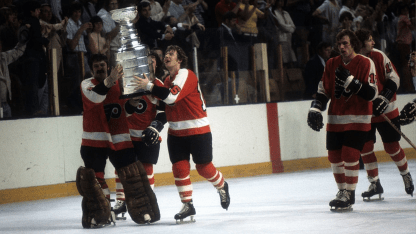
By
Bill Meltzer
philadelphiaflyers.com
- The Flyers had two players reach the 100-point milestone during the 1972-73 season: Hart Trophy winner Bobby Clarke (37g, 67a) and sniper Rick MacLeish (50g, 50a). Later, the 1975-76 Flyers would match the feat when Hart Trophy winner Clarke (39g, 89 assists for a career-best 119 points) and LCB Line left winger Bill Barber (50g, 62a) both topped 100 points.
3. The Flyers made runs to the Stanley Cup Final in three straight seasons, winning the championship in 1974 and 1975 before being defeated by Montreal in 1976. A lesser-known fact: During the Broad Street Bullies era, the Flyers reached at least the Stanley Cup semifinals in six straight years: 1973, 1974, 1975, 1976, 1977, and 1978.
4. A heart-and-soul defenseman who was a mainstay on the Flyers' first Stanley Cup team until suffering a career-ending eye in the Stanley Cup semifinals, No. 4 is retired in honor of the late Barry Ashbee. He was an assistant coach on the Flyers' 1974-75 Cup championship team. Ashbee passed away at age 37 on May 12, 1977, after a bout with leukemia. Each season, the Flyers present the Barry Ashbee Trophy to the team's top defenseman. Travis Sanheim is the most recent honoree. Additionally, for many years following his passing, the Flyers Wives Carnival was dedicated to his memory with event proceeds supporting the Barry Ashbee Research Laboratories at the Isadore Brodsky Institute for Cancer and Blood Diseases at Hahnemann University Hospital.
5. Flyers Hall of Fame right winger Reggie "the Riverton Rifle" Leach racked up a team record five-goal game against the Boston Bruins in the clinching fifth game of the 1976 Stanley Cup semifinals on May 6, 1976. The Flyers won the afternoon tilt at the Spectrum by a 6-3 score.
6, Six prominent figures from the Broad Street Bullies era Flyers are enshrined in the Hockey Hall of Fame in Toronto: goaltender Bernie Parent, center Bobby Clarke, left winger Bill Barber, head coach Fred Shero, general manager Keith Allen and majority owner/ chairman Ed Snider. The latter three are represented in the Hall's "Builders" category. Additionally, legendary play-by-play broadcaster Gene Hart was inducted in 1997 into the HHOF's broadcasters' category (Foster Hewitt Memorial Award).
7. Arguably the best all-around NHL left winger of his era, Bill Barber was drafted by the Flyers with the seventh overall pick of the 1972 NHL Amateur Draft and his No. 7 jersey was retired by the team after his 1990 induction into the Hockey Hall of Fame.
8. Flyers Hall of Fame member Dave "the Hammer" Schultz sported jersey no. 8 for the Flyers when he set an NHL single-season record with 472 penalty minutes during the 1974-75 season. He could also play the game, enjoying a 20-goal regular season (including two hat tricks in a single week), scoring a series-clinching overtime goal in the Stanley Cup quarterfinals and assisting on Clarke's famous overtime goal in Boston during the 1973-74 season. Schultz's popularity in Philadelphia that, when he recorded a novelty song called "The Penalty Box", the single was on the local top-selling 45 rpm records list in the Delaware Valley for five straight weeks and was No. 1 in local radio requests for three weeks during the summer of 1975.
9. Bob "the Hound" Kelly never played a single game of minor league hockey, going straight from junior hockey to the NHL after the Flyers selected him in the third round (32nd overall) in the 1970 NHL Amateur Draft. Wearing No. 9 throughout his Flyers' career (741 regular season matches plus 101 playoff tilts), Kelly was best known for his ultra-aggressive forechecking style and his rapid-fire fighting technique. But he also had a 22-goal season for Philadelphia when the team was riddled with injuries in 1976-77 and later notched 19 goals as a member of the KGB line with Mel Bridgman and Tom "T.J." Gorence. Most famously, Kelly scored the Stanley Cup winning goal for the Flyers in Game 6 of the 1975 Stanley Cup Final against the Buffalo Sabres.
10. The Flyers throttled the hapless Kansas City Scouts by a 10-0 score at the Spectrum on Dec. 1, 1974. Bill Barber and Ross Lonsberry netted two goals while Bobby Clarke racked up a five-point game (1g, 4a). Gary Dornhoefer, Andre "Moose" Dupont, Orest Kindrachuk, and Dave Schultz tallied one goal apiece, fourth-line center Terry Crisp added three assists and Don "Big Bird" Saleski had a pair of helpers. Bernie Parent breezed to a 22-save shutout.
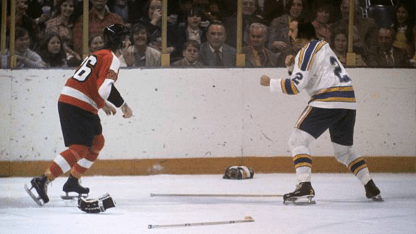
- On Dec. 11, 1977, the Flyers laid an 11-1 whipping on the lowly Cleveland Barons. This game holds a place in the NHL record books because Flyers' blueliner Tom Bladon became the first defenseman in league history to record an eight-point game (four goals, four assists). As of today, there have only been 16 eight-point games in NHL history and just two by defensemen (Bladon in 1977 and Paul Coffey on March 14, 1986). In Bladon's eight-point game, "Sparky" also set a still-standing NHL defenseman single-game record with a plus-10.
12. For most of his career in Philadelphia, Flyers Hall of Fame right winger Gary Dornhoefer wore the No. 12. A prototypical "power forward" before the term was popularized in hockey, Dornhoefer was a mainstay on the team from the inaugural 1967-68 campaign through his retirement following the 1977-78 season. Dornhoefer's overtime goal against the Minnesota North Stars in Game 5 of the 1973 Stanley Cup quarterfinal was later immortalized in a statue that stood for many years outside the Spectrum and later was in the walkway between the Wells Fargo Center and the xFinity Live! building.
13. A two-time NHL All-Star and two-time Barry Ashbee Trophy winner during his Flyers career, the late Bob "the Count" Dailey was one of the hardest-shooting defensemen in the NHL during the 1970s to early 1980s. Despite battling a shoulder injury, Dailey had a 13-goal season during Philadelphia's 1979-80 season. He was even better in the playoffs, racking up 17 points (4g, 13a) in 19 playoff games for the Stanley Cup Finalist club. Dailey's best season was in 1977-78 when he became the first Flyers defenseman to post a 20-goal season (21 goals, 36 assists). Sadly, a devastating leg injury on Nov. 1, 1981, prematurely ended a 28-year-old Dailey's career in its prime.
14. On Valentine's Day in 1977 (Feb. 14, 1977), Flyers' rookie forward Al Hill made his NHL debut and became the unlikely holder of a still-standing NHL record. Hill notched five points (two goals,three assists) in his first NHL game. Perhaps sensing something special was brewing, broadcaster Gene Hart exclaimed, "Hey! He scored faster than you can say Al Hill!" when the player gave the Flyers a 1-0 lead just 36 seconds into the first period of an eventual 6-4 win at the Spectrum over the St. Louis Blues. Hill's NHL record debut has never been tied, much less broken. Keep in mind: every debuting player gets only one crack at it!
15. On Feb. 15, 1970, the Flyers chased the Los Angeles Kings out of the Spectrum in a 7-1 rout that saw Philly outshoot LA by a 55-31 margin. Bill Sutherland paced the Flyers offensively with two goals and an assist. Philly also received tallies from Terry Ball, Simon Nolet, Earl Heiskala, Gary Peters and Jim Johnson. Rookie center Bobby Clarke chipped in two assists, as did Andre Lacroix and Gary Dornhoefer (who also dropped the gloves in a second period fight). Bernie Parent made 30 saves to earn the win.
16. Bobby Clarke wore his iconic No. 16 jersey for all but two games of his Hall of Fame career. Prior to a road game in Winnipeg on Feb. 27, 1981, Clarke's jersey was stolen from the Flyers locker room. There was a number 36 jersey available, so Clarke wore it for that game (a 6-3 win) as well as a 4-2 road win over the Minnesota North Stars the next night. By the time the Flyers were back in action for their next game, Clarke had a new No. 16 sweater. Other than those two games, Clarke wore No. 16 for his entire 1,144 regular season career plus 136 playoff games.
17. A member of both the United States Hockey Hall of Fame and the Flyers Hall of Fame, Paul Holmgren wore No. 17 throughout his Flyers career. He was not the first American-born player in Flyers history (Wayne Hicks, a member of the inaugural 1967-68 team, holds that distinction) but he was the first American to become a mainstay in the Flyers' lineup. During the 1979-season, Holmgren skated on the right wing of the "Rat Patrol" line with rookie left wing Brian Propp and center Ken "the Rat" Linseman. Holmgren posted 30 goals and 267 penalty minutes. During Game 2 of the 1980 Stanley Cup Final against the New York Islanders, Holmgren became the first American player in NHL history to compile a hat trick in a Stanley Cup Final game. In total, Holmgren had 10 goals and 20 points in 18 games during the 1980 playoffs.
18. One of the most underrated Flyers of the Broad Street Bullies era was No. 18, Ross Lonsberry. A two-way forward who contributed on both ends of special teams. Lonsberry played on a line with Rick MacLeish and Gary Dornhoefer that ably supported the Flyers top line centered by Clarke. "Roscoe" topped the 20-goal mark four times as a Flyer including a career-best 32-goal season in 1973-74. During the team's post-Cup years, Lonsberry remained a tenacious player who could be used in a variety of spots in the lineup by Shero. In 1976-77, Lonsberry posted a plus-42 rating. The 1977-78 season was Lonsberry's final campaign as a Flyer. That year, he had 18 goals, 45 points and a plus-41 rating in 78 games.
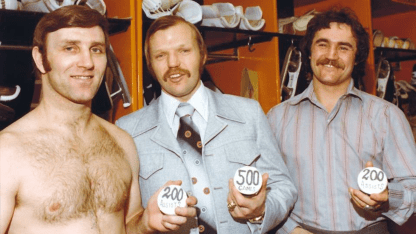
- Reggie Leach's 19 goals during the 1976 Stanley Cup playoffs still stands as an NHL single-year playoff record. It was later tied by Hockey Hall of Fame right winger Jari Kurri but has never been broken. Leach was awarded the 1976 Conn Smythe Trophy as playoff MVP despite the fact that the Flyers were defeated by Montreal in the Final.
20. Flyers Hall of Fame defenseman Jim Watson played in five NHL All-Star Games and the 1976 Canada Cup during his stellar career. Along with older brother and fellow Flyers Hall of Fame member Joe Watson (himself a two-time NHL All-Star), the Watson brothers were mainstays on both Flyers' Stanley Cup champions. A serious back injury forced Jimmy Watson to retire at age 29 after the 1981-82 season.
21. The late "Cowboy" Bill Flett wore No. 21 during his two-plus seasons with the Flyers after coming over from the LA Kings in a blockbuster trade on January 28, 1972. Easily recognizable for his heavy beard, Flett was not a fleet skater or deft puckhandler but he had an excellent right-handed shot. Playing right wing on Bobby Clarke's line in 1972-73, Flett racked up a career high 43 goals and 74 points in 1972-73.
22, Who was the Flyers leading scorer in the years before the team was built around the likes of Bobby Clarke, Bill Barber and Rick MacLeish? The answer: diminutive French Canadian puck wizard Andre Lacroix. Between the 1967-68 and 1970-71 seasons, Lacroix posted a combined 128 points (52g, 76a) in 167 games; leading the team both in goals and assists. During the 1969-70 campaign, "Andy" scored 22 goals among his team-high 58 points. An immensely popular player in Philadelphia in the early years, Lacroix was recruited along with Bernie Parent to play for the World Hockey Association's Philadelphia Blazers in 1972-73, for whom he posted 50 goals and 124 points. Lacroix was the WHA's all-time leading scorer with 798 points in 551 games.
23. Don "Big Bird" Saleski is remembered by many fans as one of the Broad Street Bullies era contingents of frequent fighters. However, as he developed over the course of his career, he became a more versatile forward. During the three season period between 1975-76 and 1977-78, Saleski averaged 23 goals a season with a high of 27 tallies during the 1977-78 campaign. After racking up a career-high 205 PIM in 1972-73, he never again posted more than 131 PIM and a season. As his role changed and expanded under Fred Shero, Saleski posted 40-plus points in three of five years and 20-plus goals in each of his last three seasons in Philadelphia. Over his final four-plus seasons as a Flyer, Saleski topped out at 68 PIM while notching a combined 23 special teams goals including eight shorthanded tallies.
24. Depth defenseman Ralph MacSweyn wore No. 24 during the longest NHL stint of his Flyers career."Big Mac" spent portions of four seasons with the Flyers in the late 1960s to early 1970s for a combined total of 47 regular season matches and 8 playoff games. He took great pride in being part of the organization during its formative years. MacSweyn passed away on May 21, 1995, at the age of 52. His gravesite in Glengarry, Ontario, depicts MacSweyn in a Flyers' uniform.
25. Most Flyers fan are familiar with the lure surrounding the team's famous 4-1 win over the Red Army (CSKA) team at the Spectrum on Jan 11, 1976, Less famous are a 6-1 rout of top Czechoslovakian team HC Pardubice team on Dec. 26, 1977, and a 4-4 tie with the Soviet Wings on Jan. 2, 1979. In the latter game, the Flyers were forced to rally from a 3-1 deficit to come back for a tie. Philadelphia peppered goalie Vladimir Myshkin with 25 shots over the final 40 minutes (after registering just six in the first period). Even then, it took two goals by Bobby Clarke in the final 2:29 of the game to forge a tie. The final goal came with just 16 seconds left to play. Clarke finished the game with three points (2g, 1), while linemates Reggie Leach (1g, 1a) and Bill Barber (0g, 2a) had two points apiece along with Rick MacLeish (1g, 1a).
26. Two-way center Orest Kindachuk wore uniform No. 26 and scored 26 goals (amid a 75-point season in 76 games) during the 1975-76 season; his most productive season as a Flyer. Back on Nov. 9, 1974, Kindrachuk carved out a piece of Flyers' history for himself. He became the first Flyer to score a goal on a penalty shot attempt. The netminder was Washington Capitals' goalie Michel Belhumeur, a former Flyer.
27. Number 27 was Reggie Leach's uniform number for almost all of his eight seasons with the Flyers (he very briefly had No, 5). Leach's 61-goal season in 1975-76 still stands as a Flyers single-season record and his 19 playoff goals in the 1976 Stanley Cup playoffs is an NHL record. While No. 27 is associated with Leach among fans who grew up during the Broad Street Bullies era, those who became fans in the mid-1980s to mid-1990s most commonly think of goalie Ron Hextall in conjunction with No. 27. Both Leach and Hextall are members of the Flyers Hall of Fame. It's similar with No. 12. If you grew up in the 1970s, Gary Dornhoefer might be the first No. 12 to come to mind. In the 1980s, it was prolific goal-scorer Tim Kerr's number. In the first decade of the 2000s, Simon Gagne wore 12 with distinction.

- Andre "Moose" Dupont notched only 28 points in 108 playoff games with the Flyers (to go along with 306 playoff penalty minutes). However, many of the points the defenseman collected were timely ones. Most notably, Dupont's goal in the final minute of regulation in Game 2 of the 1974 Stanley Cup Final forced overtime and set the stage for Bobby Clarke's iconic OT game-winner. In Game 6 of the 1974 Final, Dupont assisted on Rick MacLeish's power play deflection goal that stood as the lone tally for either team in the Flyers' Cup clinching win. In 1975, Dupont's overtime goal clinched the Quarterfinal series against the Toronto Maple Leafs. A year later, Dupont scored a crucial Game 7 goal vs. Toronto. When Dupont scored one of his goals, especially in a big situation, he'd launch into the "Moose Shuffle"; a celebratory "dance" that was more an arm-swinging, knee-pumping run on skates.
29. Before the Flyers established a record 35-game unbeaten streak in 1979-80 (see No. 35 below), the old NHL record was 28 straight games. The record breaking 29th game of the streak came in a 5-2 win at the Boston Garden on Dec. 22, 1979. Bobby Clarke recorded his 900th career regular season point in the same game. The Flyers' previous lengthiest unbeaten streak came in 1975-76 at 22 games without a loss.
30. Flyers rookie left winger Bill Barber notched 30 goals and 64 points in 69 games during the 1972-73 season. He was the top runner-up for the Calder Trophy as NHL Rookie of the Year to Steve Vickers of the New York Rangers.
31. Flyers goalie Doug Favell was in the Halloween spirit when he first debuted an orange spray-painted mask in an Oct. 31 game against the Montreal Canadiens. Favell became the first NHL goaltender to sport a painted mask.
32. The late Bill Sutherland was a 32-year-old "rookie" when the 1967 Expansion Draft provided the career minor leaguer with a long belated chance to play in the NHL. Sutherland holds the distinction of scoring both the first road goal and the first home goal in Flyers history. Sutherland had two different stints with the Flyers: the 1967-68 season, 1968-69 to early in the 1970-71 season after being claimed by the Minnesota North Stars from the Flyers, flipped to Toronto and traded back to Philly on March 2, 1969; A strange-but-true story about Sutherland: When he reported to the Spectrum for the first home game in team history, a security guard refused to let him enter the building, saying he looked "too old to be a professional athlete." Thankfully, Flyers management straightened things out in time for Sutherland to play in the game and score the only goal in the team's 1-0 win against the Pittsburgh Penguins.
33. Mid-1970s backup goaltender Jeremy "Moses" Mrazek was best known for the bushy mustache and beard that inspired his nickname. He also was known for playing the guitar and singing to entertain teammates. Mrazek only appeared in one NHL game, sporting number 33 during a six-minute appearance in relief of Wayne Stephenson late in the third period of an 8-2 blowout win at the Spectrum against the St. Louis Blues.
34. How hard was it to beat the Flyers at the Spectrum during the heyday of the Fred Shero era? The team lost a COMBINED 34 games on home ice over the six-year period between 1972-73 to 1977-78: an astounding 185-34 record plus 19 ties. The Flyers' .817 points percentage at home led the entire NHL during that time period; better even than the Montreal Canadiens (.805). The Flyers averaged 4.39 goals per game on home ice during these years (3rd best in the NHL) and yielded a stingy 2.06 goals per game (by far the best in the NHL with Montreal second with a team 2.40 GAA).
35. The Flyers' 35-game unbeaten streak (25 wins, 0 losses, 10 ties) ran from Oct. 14, 1979 to Jan. 6, 1980. The streak, which remains to this day a record not only in the NHL but across all North America professional sports, started in the third game of the 1979-80 regular season after Philly opened the campaign at 1-1-0. Among the 10 ties in the streak, the Flyers scored the last (tying) goal in only two of the games. Over the course of the streak, the Flyers played every team in the NHL but one (the Washington Capitals) at least once. The streak was finally ended by the Minnesota North Stars on Jan. 7, 1980.


